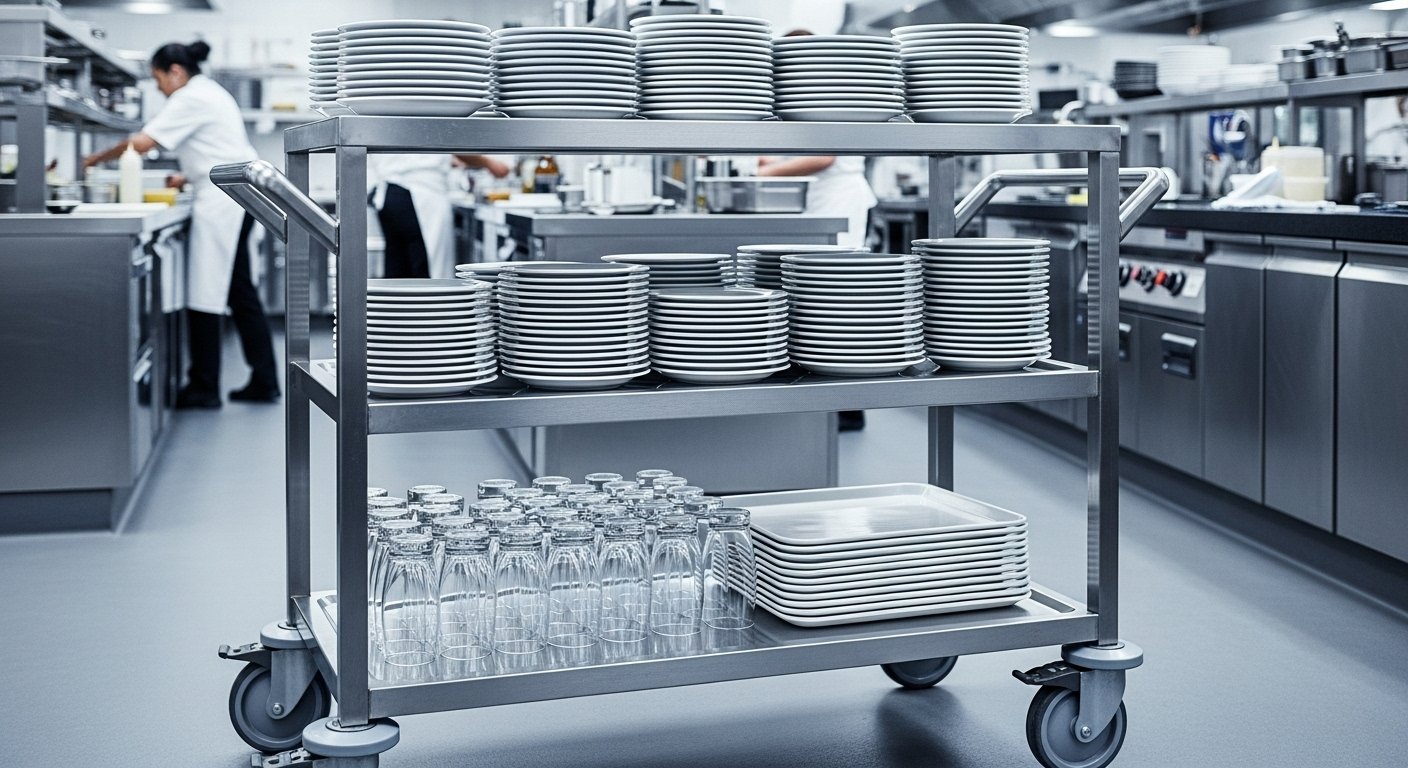Afruimwagens, the Dutch term for versatile clearing trolleys, have become indispensable in busy hospitality environments like restaurants, hotels, and catering services. These multi-shelf carts streamline the process of collecting and transporting dirty dishes, trays, and cutlery, reducing trips and enhancing efficiency. If you’ve ever wondered how professional kitchens stay organized during peak hours, afruimwagens play a key role by minimizing physical strain and maintaining hygiene standards.
In this guide, we’ll explore everything from their origins to practical usage, helping you understand why afruimwagens are a smart investment for any service-oriented business. Whether you’re a restaurant manager or event planner, incorporating these trolleys can transform your workflow.
What Are Afruimwagens?
Afruimwagens originate from the Dutch word “afruimen,” meaning “to clear away,” and refer to specialized trolleys designed for gathering and moving used tableware. Unlike basic carts, afruimwagens feature multiple tiers for organized stacking, making them ideal for high-volume settings where speed is crucial.
These trolleys typically include sturdy wheels for smooth navigation through crowded dining areas and optional compartments for separating waste from dishes. In English-speaking regions, they’re often called dish clearing trolleys, bussing carts, or service trolleys, but the term afruimwagens highlights their European roots in efficient hospitality practices. For USA businesses expanding into international styles, adopting afruimwagens aligns with global standards for quick table turnover.
The core design focuses on functionality: shelves spaced to fit plates, glasses, and utensils without toppling, plus handles for easy pushing. This setup not only speeds up clearing but also prevents accidents, like spills that could disrupt guest experiences. Have you noticed how seamlessly staff in top hotels handle post-meal cleanup? That’s the power of a well-chosen afruimwagen at work.
History and Evolution of Afruimwagens
Afruimwagens trace back to mid-20th century Europe, where Dutch and German hospitality innovators sought ways to handle growing demand in post-war dining scenes. Initially simple wooden carts, they evolved with industrial materials like stainless steel during the 1970s to meet hygiene regulations in expanding hotel chains.
By the 1990s, afruimwagens incorporated ergonomic features, such as adjustable heights, responding to worker safety concerns in labor-intensive kitchens. Today, in the USA, similar trolleys appear in casual dining spots and fine establishments, influenced by European imports that emphasize durability and mobility.
This evolution reflects broader trends in hospitality toward sustainability and efficiency, with modern afruimwagens often using recyclable plastics alongside metals. Brands have innovated with foldable designs for compact storage, adapting to urban spaces where every square foot counts. Understanding this history shows why afruimwagens remain relevant: they’re not just tools, but solutions refined over decades.
Types of Afruimwagens
Afruimwagens come in various types to suit different hospitality needs, from small cafes to large banquets. The most common include standard multi-shelf models for general use, which feature two to four tiers for balanced loading.
Compact afruimwagens are perfect for tight spaces, like boutique restaurants, with narrower frames and lighter builds that still hold up to 100 kg. For high-volume operations, heavy-duty versions with reinforced frames and larger wheels handle over 200 kg, ideal for hotel buffets. Specialized types, such as those with built-in waste bins, cater to eco-conscious venues focusing on recycling.
Another variant is the modular afruimwagen, where shelves can be customized or removed for versatility in catering events. Choosing the right type depends on your daily plate turnover—think about peak lunch rushes when a basic model might fall short. These options ensure every business finds an afruimwagen that fits seamlessly into operations.
Key Features and Materials in Afruimwagens
High-quality afruimwagens boast features like swivel casters with brakes for precise control in busy aisles. Multiple shelves, often adjustable, allow for stacking plates on lower levels and lighter glasses above, preventing shifts during transport.
Ergonomic handles at waist height reduce back strain, a common issue in hospitality work. Optional add-ons, such as cutlery trays or bag holders, enhance organization, keeping everything contained until reaching the dishwashing area.
Materials play a crucial role: stainless steel offers rust resistance and easy sanitization, essential for food safety compliance. Durable plastics like polypropylene provide lightweight alternatives that dampen noise, perfect for upscale dining where quiet efficiency matters. Aluminum frames combine strength with portability, while rubber-edged shelves protect delicate items. These elements make afruimwagens reliable for daily grinds, from morning breakfast services to evening banquets.
Benefits of Using Afruimwagens in Hospitality
One major benefit of afruimwagens is their ability to cut clearing time by up to 50%, allowing staff to focus on guest service instead of multiple trips. This efficiency boosts table turnover rates, directly impacting revenue in fast-paced restaurants.
Safety improves as well, with trolleys eliminating the need to carry heavy stacks, reducing slip-and-fall risks in wet kitchen floors. Hygiene standards rise too, as contained dirty items prevent cross-contamination with clean areas. For team morale, the ergonomic design lowers injury rates, leading to fewer sick days and higher productivity.
Cost savings emerge over time: durable afruimwagens last years with minimal upkeep, offsetting initial purchases through labor efficiencies. In sustainable practices, models with recyclable materials support green initiatives, appealing to eco-aware customers. Imagine a hotel where clearing is effortless— that’s the real-world advantage afruimwagens bring to operations.
Sizes and Capacities for Different Settings
Afruimwagens vary in size to match venue scales, with small models measuring about 80 cm wide for navigating narrow cafe paths. These hold 50-100 kg, suitable for solo operators handling light lunches.
Medium-sized afruimwagens, around 100 cm wide, accommodate 100-150 kg and fit standard restaurant layouts, balancing capacity with maneuverability. Large variants, exceeding 120 cm, manage 200+ kg for event halls, featuring extra shelves for bulk service.
Capacity considerations include wheelbase stability; wider bases prevent tipping in crowded spaces. For schools or corporate cafeterias, height-adjustable options from 90-120 cm ensure accessibility for all staff. Selecting the right size means assessing your peak load— a mismatched trolley can slow down even the smoothest service.
How to Choose the Right Afruimwagen
Start by evaluating your venue’s traffic: high-end restaurants might prioritize quiet, plastic models, while buffets need robust steel ones. Budget plays a role—entry-level afruimwagens start at $200, while feature-rich versions reach $800.
Consider wheel type: polyurethane for quiet floors, rubber for carpeted areas. Test for load distribution; shelves should support even weight without sagging. Brand reliability matters—look for warranties and user reviews from similar hospitality pros.
Customization options, like adding hooks for aprons, add value for tailored fits. Finally, check compliance with USA safety standards like NSF for food contact. A thoughtful choice ensures your afruimwagen enhances rather than hinders daily routines.
Safe Usage and Ergonomic Tips for Afruimwagens
Always load heavier items low to maintain balance, avoiding top-heavy stacks that could tip. Engage brakes during loading to prevent rolling, especially on sloped kitchen floors. Push from the rear with straight posture, keeping elbows bent to minimize strain.
Train staff on pathways: clear routes reduce collision risks in peak hours. For ergonomics, select heights matching average user stature—around 100 cm handles work for most. Regular checks on wheel locks ensure stability, preventing accidents during transport.
Incorporate rest breaks; even efficient tools can’t replace human care. These practices not only safeguard workers but also protect inventory from damage. What if a simple loading habit could prevent a busy night’s mishap? That’s the edge safe afruimwagen use provides.
Organization Strategies with Afruimwagens
Designate top shelves for glasses to avoid breakage from heavier plates below. Middle tiers suit bowls and side dishes, while bottoms handle trays securely. Use side pockets for utensils, keeping them sorted by type for quick kitchen sorting.
Color-code compartments if handling allergens, separating nuts from general waste. For events, attach labels to shelves for themed setups, like dessert vs. main course items. This system streamlines dishwashing, cutting sorting time by half.
Rotate loads evenly to prevent uneven wear on wheels. Adapt for specific cuisines—extra space for dim sum trays in Asian fusion spots. Effective organization turns afruimwagens into workflow heroes, not just carriers.
Maintenance and Cleaning Best Practices
Daily wipes with mild soap remove residues, preventing bacterial buildup on surfaces. Rinse shelves thoroughly and air-dry to avoid water spots that harbor germs. Inspect wheels weekly, lubricating axles for smooth spins and checking brakes for responsiveness.
Monthly deep cleans involve disassembling removable parts, using food-safe disinfectants. Tighten bolts and replace cracked plastics promptly to maintain structural integrity. Store in dry areas post-use to fend off rust on metal frames.
Follow manufacturer schedules—some recommend annual professional tune-ups. Neglect here shortens lifespan; proper care keeps afruimwagens operational for 5-10 years. Simple routines like these ensure hygiene and reliability in demanding environments.
Common Mistakes to Avoid with Afruimwagens
Overloading beyond rated capacity strains frames, leading to premature failures. Stacking mismatched items high risks collapses, especially on turns. Ignoring brake checks can cause runaway carts in sloped venues.
Mixing clean and dirty zones invites contamination, violating health codes. Skipping maintenance allows dirt accumulation, complicating compliance audits. Rushing loads without balance invites spills, disrupting service flow.
Pushing instead of pulling in tight spots causes strains—always assess space first. By dodging these pitfalls, you maximize afruimwagens’ potential without costly downtime.
Real-World Examples of Afruimwagens in Action
In a bustling New York diner, afruimwagens enable solo waitstaff to clear four tables per trip, speeding lunch rushes. Hotel chains like Marriott use large models for banquet halls, transporting 200 plates seamlessly between courses.
School cafeterias deploy compact versions for student self-clearing, teaching responsibility while easing staff loads. At catering events, modular afruimwagens adapt for outdoor setups, handling uneven terrain with all-terrain wheels.
Corporate offices integrate them in break rooms, maintaining neatness during meetings. These examples illustrate afruimwagens’ adaptability across USA hospitality landscapes.
Future Trends in Afruimwagens Design
Eco-materials like bamboo composites are emerging for sustainable builds, reducing plastic use. Smart features, such as weight sensors alerting to overloads, enhance safety via apps. Foldable, lightweight models suit delivery services in urban food trucks.
Integration with robotics hints at automated clearing in high-tech kitchens. Antimicrobial coatings combat post-pandemic hygiene demands. As hospitality evolves, afruimwagens will incorporate these innovations for even greater efficiency.
Explore More Topic: Hair Transplant Turkey Cost
Conclusion
Afruimwagens stand as quiet heroes in hospitality, blending Dutch ingenuity with practical design to elevate daily operations. From boosting speed and safety to supporting sustainability, their impact is profound in restaurants, hotels, and beyond. Investing in the right model, with proper maintenance and usage, ensures long-term gains in productivity and staff well-being. Embrace afruimwagens today to clear the path for smoother, more profitable service—your team and guests will notice the difference.
FAQ
What exactly is an afruimwagen?
An afruimwagen is a multi-tiered trolley used in hospitality to collect and transport dirty dishes, cutlery, and trays efficiently from dining areas to kitchens.
Why choose stainless steel for afruimwagens?
Stainless steel provides superior durability, rust resistance, and easy cleaning, making it ideal for high-hygiene environments like restaurants and hotels.
How do afruimwagens improve safety in busy venues?
By reducing the need to carry heavy loads manually, afruimwagens minimize injury risks like strains or drops, with features like brakes adding stability.
Can afruimwagens be customized for specific needs?
Yes, many models offer modular shelves, add-on bins, and adjustable heights to fit unique hospitality setups, from cafes to large events.

